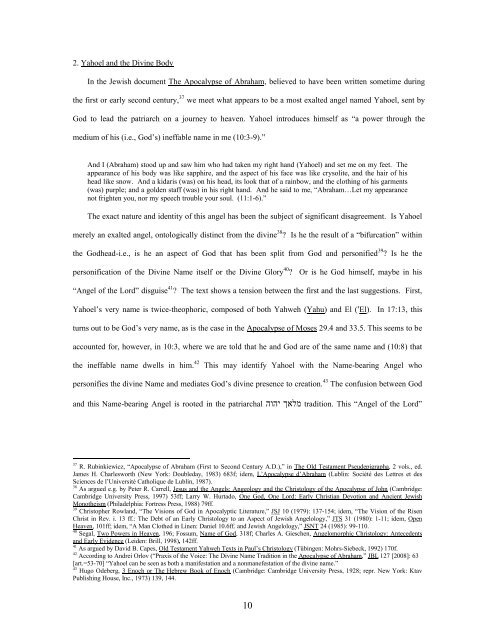Sapphiric God: - Dr. Wesley Muhammad
Sapphiric God: - Dr. Wesley Muhammad
Sapphiric God: - Dr. Wesley Muhammad
You also want an ePaper? Increase the reach of your titles
YUMPU automatically turns print PDFs into web optimized ePapers that Google loves.
2. Yahoel and the Divine Body<br />
In the Jewish document The Apocalypse of Abraham, believed to have been written sometime during<br />
the first or early second century, 37 we meet what appears to be a most exalted angel named Yahoel, sent by<br />
<strong>God</strong> to lead the patriarch on a journey to heaven. Yahoel introduces himself as “a power through the<br />
medium of his (i.e., <strong>God</strong>’s) ineffable name in me (10:3-9).”<br />
And I (Abraham) stood up and saw him who had taken my right hand (Yahoel) and set me on my feet. The<br />
appearance of his body was like sapphire, and the aspect of his face was like crysolite, and the hair of his<br />
head like snow. And a kidaris (was) on his head, its look that of a rainbow, and the clothing of his garments<br />
(was) purple; and a golden staff (was) in his right hand. And he said to me, “Abraham…Let my appearance<br />
not frighten you, nor my speech trouble your soul. (11:1-6).”<br />
The exact nature and identity of this angel has been the subject of significant disagreement. Is Yahoel<br />
merely an exalted angel, ontologically distinct from the divine 38 ? Is he the result of a “bifurcation” within<br />
the <strong>God</strong>head-i.e., is he an aspect of <strong>God</strong> that has been split from <strong>God</strong> and personified 39 ? Is he the<br />
personification of the Divine Name itself or the Divine Glory 40 ? Or is he <strong>God</strong> himself, maybe in his<br />
“Angel of the Lord” disguise 41 ? The text shows a tension between the first and the last suggestions. First,<br />
Yahoel’s very name is twice-theophoric, composed of both Yahweh (Yahu) and El ("El). In 17:13, this<br />
turns out to be <strong>God</strong>’s very name, as is the case in the Apocalypse of Moses 29.4 and 33.5. This seems to be<br />
accounted for, however, in 10:3, where we are told that he and <strong>God</strong> are of the same name and (10:8) that<br />
the ineffable name dwells in him. 42 This may identify Yahoel with the Name-bearing Angel who<br />
personifies the divine Name and mediates <strong>God</strong>’s divine presence to creation. 43 The confusion between <strong>God</strong><br />
and this Name-bearing Angel is rooted in the patriarchal הוהי ךאלמ tradition. This “Angel of the Lord”<br />
37<br />
R. Rubinkiewicz, “Apocalypse of Abraham (First to Second Century A.D.),” in The Old Testament Pseudepigrapha, 2 vols., ed.<br />
James H. Charlesworth (New York: Doubleday, 1983) 683f; idem, L’Apocalypse d’Abraham (Lublin: Société des Lettres et des<br />
Sciences de l’Université Catholique de Lublin, 1987).<br />
38<br />
As argued e.g. by Peter R. Carrell, Jesus and the Angels: Angeology and the Christology of the Apocalypse of John (Cambridge:<br />
Cambridge University Press, 1997) 53ff; Larry W. Hurtado, One <strong>God</strong>, One Lord: Early Christian Devotion and Ancient Jewish<br />
Monotheism (Philadelphia: Fortress Press, 1988) 79ff.<br />
39<br />
Christopher Rowland, “The Visions of <strong>God</strong> in Apocalyptic Literature,” JSJ 10 (1979): 137-154; idem, “The Vision of the Risen<br />
Christ in Rev. i. 13 ff.: The Debt of an Early Christology to an Aspect of Jewish Angelology,” JTS 31 (1980): 1-11; idem, Open<br />
Heaven, 101ff; idem, “A Man Clothed in Linen: Daniel 10.6ff. and Jewish Angelology,” JSNT 24 (1985): 99-110.<br />
40<br />
Segal, Two Powers in Heaven, 196; Fossum, Name of <strong>God</strong>, 318f; Charles A. Gieschen, Angelomorphic Christology: Antecedents<br />
and Early Evidence (Leiden: Brill, 1998), 142ff.<br />
41<br />
As argued by David B. Capes, Old Testament Yahweh Texts in Paul’s Christology (Tübingen: Mohrs-Siebeck, 1992) 170f.<br />
42<br />
According to Andrei Orlov (“Praxis of the Voice: The Divine Name Tradition in the Apocalypse of Abraham,” JBL 127 [2008]: 63<br />
[art.=53-70] “Yahoel can be seen as both a manifestation and a nonmanefestation of the divine name.”<br />
43<br />
Hugo Odeberg, 3 Enoch or The Hebrew Book of Enoch (Cambridge: Cambridge University Press, 1928; repr. New York: Ktav<br />
Publishing House, Inc., 1973) 139, 144.<br />
10
















